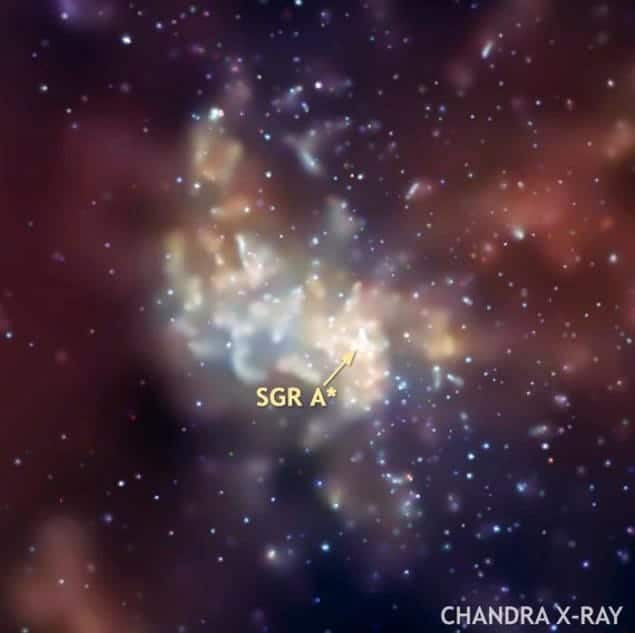
An immense cloud of gas currently swooping around the centre of our galaxy could reveal a multitude of small black holes nestled close to its heart. Over the next 12 months, the G2 gas cloud will pass through the galactic centre where, according to the calculations of astrophysicists in the US, encounters with small black holes will produce bursts of radiation that could be detectable using space telescopes.
Since the 1970s astronomers have postulated that a throng of small black holes lurks incognito near Sagittarius A*, the supermassive black hole at the centre of the Milky Way. Through a process known as dynamical friction, the most massive objects in the galaxy slow down as they move through the interstellar medium, and so drift gradually towards the centre. Based on star formation and death rates, simulations predict a population of around 20,000 small-scale black holes in the innermost region of the galaxy, each with a mass several times that of our Sun. So goes the theory, anyway, but until now there has been no way of actually testing it.
Unique opportunity
The G2 cloud, which was first spotted heading for the galactic centre in 2011, presents a unique opportunity for scientists to finally catch a distant glimpse of one or more of these stellar-mass black holes. The cloud itself is three times the size of Pluto’s orbit around the Sun (with a mass three times that of the Earth), whereas the black holes span only a few tens of kilometres each. As G2 encounters them, the gas will be spun, jostled and heated, causing it to emit X-rays, which could potentially be seen by telescopes such as NASA’s NuSTAR and Chandra.
Imre Bartos, of Columbia University in New York City, and colleagues, looked at simulations depicting the number and distribution of stellar black holes, together with the predicted trajectory of the gas cloud, and calculated that G2 should encounter around 16 such objects on its journey. Next, they looked at how much radiation these encounters should produce, and the chances of existing instrumentation being able to spot their faint signals from 25,000 light-years away.
“Conservatively, most of the stellar-mass black holes would not be detectable. But it’s not negligible at all,” says Bartos, stressing that uncertainties linked to their limited information about the cloud’s density and speed can cause the radiation value to change by a factor of a hundred.
More promising, perhaps, is the prospect of finding evidence for so-called intermediate-mass black holes. “We know [from observation] that there are black holes a few times the mass of the Sun. We also know about supermassive black holes that are millions-to-billions of times heavier than the Sun. But we don’t have much evidence for anything between these two, which is puzzling,” Bartos explains. If such intermediate-mass black holes exist anywhere in the galaxy, dynamical friction would jostle them towards the centre too, and their encounters with G2 would produce significantly more and brighter radiation than their smaller counterparts.
Holding out for a hint
The work brings a fresh perspective to discussions that have so far focussed on how G2 will interact with the beefy supermassive black hole at the centre of the Milky Way, the mass of which is four million times that of the Sun. “It’s a very interesting idea, which we hadn’t thought of at the time when we were writing our discovery paper,” admits Stefan Gillessen of the Max Planck Institute for Extraterrestrial Physics in Garching, Germany – the man credited with first spotting G2 back in 2011.
Columbia University’s Charles Hailey, co-leader of the data analysis team for the NuSTAR X-ray telescope, who was not involved in the research, says that, due to the uncertainties involved “it will take some good fortune for the numbers to conspire to produce X-ray fluxes observable by Chandra or NuSTAR.” Even with the most favourable numbers, the signal risks being obscured by strong X-ray emission from G2’s interaction with Sagittarius A*. For now, NuSTAR will take cues from the Chandra and Swift observatories, and will train its equipment on the galactic centre “immediately” in the event that either of these groups notice interesting activity from that direction.
And that could be any day now. G2’s orbit traces a long and narrow ellipse over a period of a few hundred years, but its 2011 discovery was fortuitous; astronomers calculate that it will make its closest approach to Sagittarius A* in early 2014. “It’s an extremely rare thing in astrophysics or astronomy,” says Bartos. “We talk about timescales of billions of years and then here’s something that has only just been observed that is about to get into the most interesting part within a year or two.”
The research is published in Physical Review Letters.



